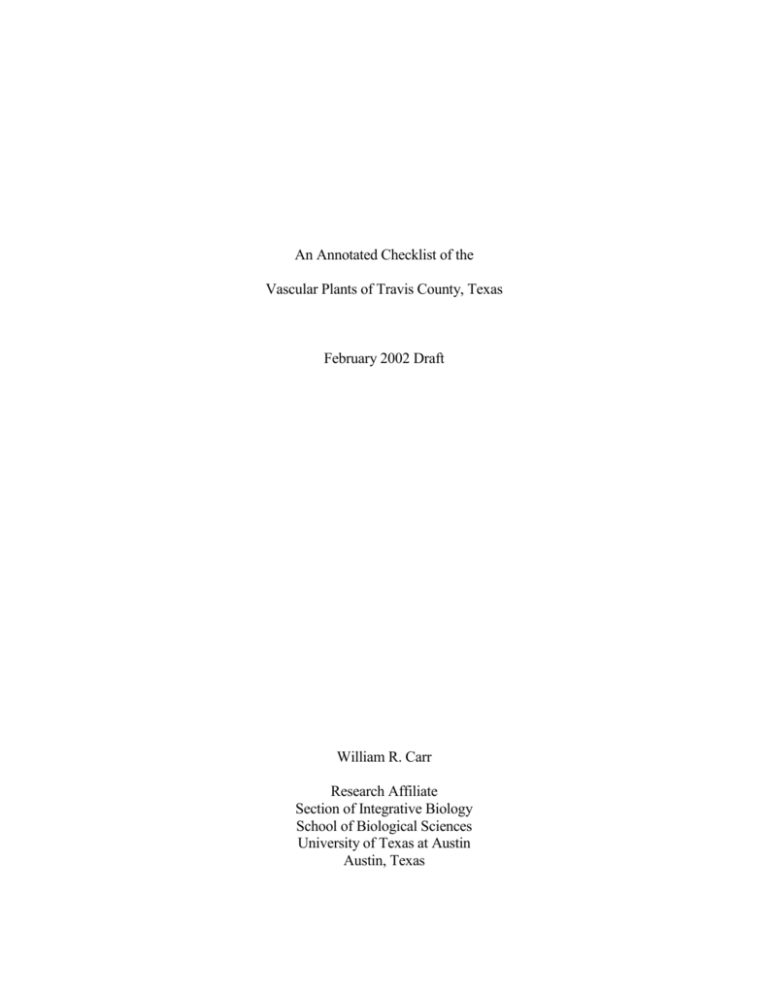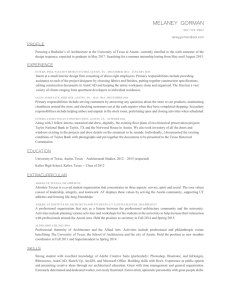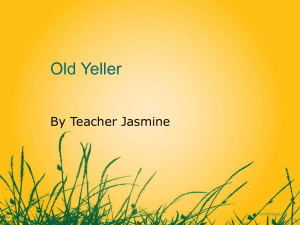Acknowledgements - Native Plant Society of Texas
advertisement

An Annotated Checklist of the Vascular Plants of Travis County, Texas February 2002 Draft William R. Carr Research Affiliate Section of Integrative Biology School of Biological Sciences University of Texas at Austin Austin, Texas Dedicated to Brother Daniel Lynch Notes on the January 2004 Draft The following list includes all of the vascular plant taxa, both native and naturalized, that are known to occur in the wild anywhere within Travis County. A first draft was completed in 1996. In this February 2002 draft, nomenclature has been updated to reflect some of the multitude of subsequent changes. It now corresponds more or less to that used in the Flora of North Central Texas (Diggs, Lipscomb & O'Kennon, 1999), the most useful flora for the Travis County area. Principal sources of information include the collections at the Plant Resources Center at The University of Texas at Austin (TEX-LL); smaller but obviously relevant herbaria maintained by the Balcones Canyonlands National Wildlife Refuge (BCNWR), the City of Austin's Office of Environmental Resource Management (COA), and the Travis County Transportation and Natural Resources Department (TCTNRD); previous regional floras (Young, 1920; Brown, 1948; Higdon, 1948; Lynch, 1974); published systematic literature; and unpublished plant lists from local managed areas (e.g., Lyter, 1986; Muzos, 1986; Sexton, 1996). Arrangement follows the traditional Engler and Prantl sequence of plant families, except within the Pteridophyta where the more modern treatment in Volume Two of the Flora of North America (various authors, 1993) is adopted. Genera, species, and subspecific taxa are arranged alphabetically. Annotations for each taxon include a brief estimate of its local abundance and a description of its habitat. Both are based on the perceptions of the author and may be biased in any number of ways. An apology must be offered for the lethargy of much of the prose in the current draft; hopefully at least some sections will be improved during moments of inspiration in the near future. Specimen citations are provided for the less common taxa. In such cases all of the sheets at TEXLL, but only a selected few of the specimens at smaller herbaria, are included. For the more common taxa, only the number of sheets at TEX-LL is mentioned. It could be argued that citations are of little value, particularly those of specimens with labels providing nothing more than the word "Austin," a date and the name of the collector. Nonetheless they are offered here for the benefit of the curious, to generate interest in the relatively few collectors (Mary Sophie Young, B. C. Tharp, Annie Armer, Barton Warnock, Fred Barkley, A. M. Ferguson and others) who contributed so much to the persistent knowledge of the local flora in the first half of the 20th Century, and perhaps to demonstrate the comparative dearth of local collections since then. A historical perspective was also the motive behind the inclusion of references to "previous Travis County floras." Both floras-- the first account of the plants of "the Austin region" by Mary Sophie Young, posthumously published in 1920, and the 1974 account of the plants of an urban subset of Travis County by Brother Daniel Lynch-- are fascinating treatments of which some students of the local flora may be unaware. i Finally, it should be pointed out that this effort toward a florula of Travis County is incomplete. Additions and corrections are both welcome and encouraged. The author can be contacted at 6106 Woodview, Austin TX, 78757, at (512) 459-5326, or at bcarr@tnc.org. Acknowledgements This project, which has consumed the happiest and sanest bit and pieces of my free time virtually since the moment I first set foot in Travis County in 1981, would not have been as rewarding without the help of a host of others who share a keen interest in the local flora. First and foremost among these friends is the late Brother Daniel Lynch, who in the early 1980's invited me to accompany him and Edward A. Kutac in their investigations toward a flora of the nineteen-county area surrounding Austin. The botanical education Brother Daniel provided (and the introduction to ornithology Ed provided) on Saturday trips during the next three or four years were well worth the price of smelling Ed's sardine lunches. This project simply would not have been possible without the help of the Section of Integrative Biology, School of Biological Sciences at the University of Texas at Austin and its Plant Resources Center. In their various capacities, Dr. Billie Turner, Dr. Beryl Simpson, and Dr. Carol Todzia never failed to make me feel at home despite the comparatively parochial nature of my task. Dr. Turner's unique brand of vociferous support, to which all of his many students have been treated, was also extended to-- and greatly appreciated in-- this more informal setting. Over the years Dr. Mark Mayfield and Dr. Guy Nesom assisted with determinations of countless specimens and the occasional enlightening field trip, and more recently Dr. Tom Wendt has continued this fine tradition of enthusiasm. I am also indebted to Dr. Stanley Jones and Dr. Jay Wipff for the identification of hundreds of specimens of Cyperaceae and Poaceae from various parts of Texas, including Travis County. Thanks is also due to the staff of the now-defunct Texas Natural Heritage Program, and in particular to its former coordinator, Dr. David D. Diamond. Work on David's various projects offered me the opportunity to become at least passingly familiar with the flora of all other parts of the state. Although more interested in big-picture ecology, David, along with fellow botanist Jackie Poole, always encouraged my interest in the minutiae of the Travis County flora, and he scoffed at my resistance to conduct such research on the clock during my tenure with the program from 1988 until 1995. During that same era, David Riskind of the Public Lands Division of Texas Parks and Wildlife also broadened my horizons, sometimes directly but more often via a cryptic remark the import of which was not discerned until much later. A debt of gratitude is also owed to the Travis County Transportation and Natural Resources Department, which employed me during the summer of 1996 to, among more useful tasks, look for interesting plants on Travis County parks. Clif Ladd, Terri Siegenthaler, Phil Koepp and others never failed to get excited about each and every remotely unusual plant record that surfaced. That ii job was brief and was conducted during the worst drought in at least fifteen years, but all of the information gathered was quite germane to this project. Several interesting records came to light during a 1999-2000 inventory of watershed protection areas managed by the City of Austin Water and Wastewater Department. Willy Conrad is thanked for access to the tracts. A special thanks is extended to a small cadre of other folks whose intimate working knowledge of and unabashed interest in the flora of Travis County has been the source of new records as well as different perspectives on old familiar species. Marshall Enquist, Pat McNeal, Dr. Chuck Sexton, Paul Turner and Burford Westlund have all contributed more to this project than they would be willing to admit. Going out and looking at plants would not have been nearly as educational without their varied insights and certainly not as much fun without their company. Last but never least I must thank my wife, Dr. Mary Lou Price, who has graciously tolerated my episodic obsession with this project and other botanical foolishness during the past fifteen years. iii





